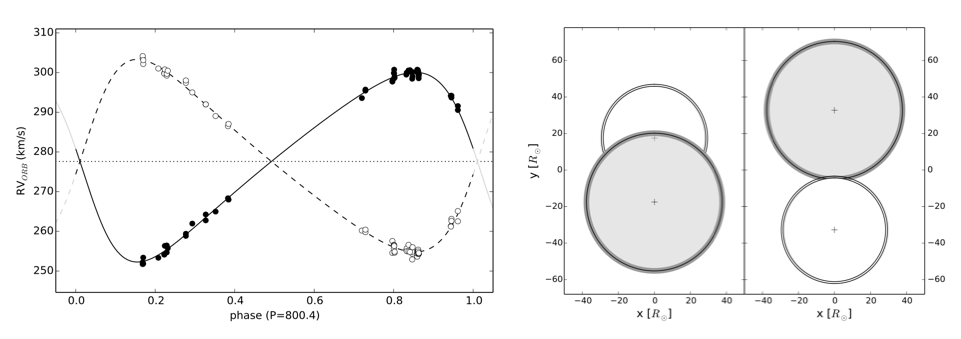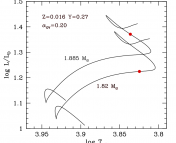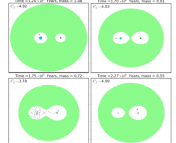- Title: The Araucaria Project: The First-Overtone Classical Cepheid in the Eclipsing System OGLE-LMC-CEP-2532
- Authors: B. Pilecki, D. Graczyk, W. Gieren, G. Pietrzyński, I. B. Thompson, R. Smolec, A. Udalski, I. Soszyński, P. Konorski, M. Taormina, A. Gallenne, D. Minniti, and M. Catelan
- First Author’s Institution: Millennium Institute of Astrophysics, Santiago, Chile
- Paper Status: Accepted for publication in ApJ
Today in “why is my star’s brightness changing?”, let’s take a look one of the craziest light curves this astrobiter has ever seen.

A pulsating Cepheid variable in an eclipsing binary makes for one crazy light curve. Because the pulsation period is close to 48 hours, and observations (black points) are only possible every 24 hours (at night), a pattern known as “beating” appears to the eye. A model of the pulsing, eclipsing system (solid line) illustrates the true nature of this system.
In the figure above, the black points are brightness observations measured in the near-infrared I-band. The solid line is the model created by the authors of today’s paper to explain what is happening. There are two things going on here: a pulsating Cepheid variable (rapid brightness changes) is being eclipsed by an orbiting companion star (the large dip) every 800 days.
Classical Cepheid variables are an observer’s best friend. They obey a period-luminosity relation—intrinsically brighter Cepheids pulsate more slowly—that makes them incredibly useful for measuring cosmic distances. The chance discovery of a Cepheid variable star in Andromeda in 1924 by Edwin Hubble was a turning point in modern astronomy. Measuring a huge distance to Andromeda meant that it and other faint, fuzzy blobs in the sky we now know as galaxies were definitively not part of our own Milky Way. The subject of today’s paper is actually located in our neighboring Large Magellanic Cloud (LMC) dwarf galaxy.
More than a cosmic meterstick
Cepheids are interesting stars in their own right, too. The pulsing brightness variations happen because the star’s temperature and radius is changing, and they occupy a unique niche of stellar evolution. Not all stars go through a Cepheid phase of life, but those with masses ranging from about 4–20 M☉ do. Some stars can actually cross into the so-called instability strip and become Cepheids more than once! Overall, though, the Cepheid variable portion of a star’s life is extremely short. We can learn a lot about what is physically happening inside stars during this tumultuous time through close observations.
Or rather, we could learn a lot about what happens inside Cepheid variable stars, if only we knew their masses. As for all stars, a Cepheid’s mass is the key to understanding its fate. Since we lack a cosmic bathroom scale, the only direct way to measure the mass of a star is when you can observe something else orbiting it.
Until as recently as 2010, we knew of no Cepheids in eclipsing binaries with observable signals from both stars. Today, there are just a few, including our friend OGLE-LMC-CEP-2532, so it is critical to measure their masses as accurately and precisely as possible.

Radial velocities of both stars in the Cepheid binary (left) and a schematic of the eclipse configurations as seen from Earth (right). In the velocity curves, filled points are the Cepheid with pulsations removed and open points are the companion. A full orbit takes 800 days. The system has an eccentric orbit, which can be seen from the non-sinusoidal velocity curves, and both stars have similar masses. It is not clear if the Cepheid (shown in white, right) actually eclipses a portion of its companion (shown in gray, right) or not.
As it turns out, this binary star’s orbit is very eccentric, yet the two stars have similar masses. This is apparent from the bow-tie shape of the radial velocity curve above. And while the companion star does pass in front of the Cepheid, the authors cannot say for sure if the Cepheid just barely passes in front of its companion.
To fully characterize both stars in a binary, you need two eclipses, otherwise the stars’ masses are conflated with the geometry as viewed from Earth. However, just knowing that the secondary eclipse is “close but not visible” helps constrain the inclination in Markov chain Monte Carlo simulations. In the end, the authors are able to measure the Cepheid’s mass as 3.90 ± 0.10 M☉. This is one of the most accurate mass determinations for a classical Cepheid and will go a long way toward improving our understanding of Cepheids’ inner secrets.




